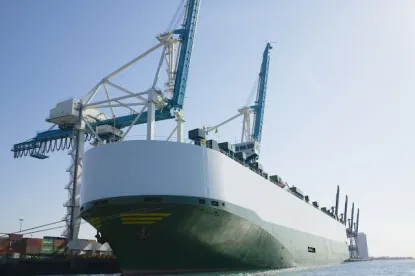In Air & Liquid Sys. Corp. et al. v. DeVries et al., No. 17-1104 (March 19, 2019), the U.S. Supreme Court held that under federal maritime law, a product manufacturer has a duty to warn when its product requires the incorporation of a part that the manufacturer knows or should know to be dangerous and the manufacturer has no reason to believe that the product’s users will realize that danger. In so holding, the Court declined to recognize both the so-called “bare metal defense,” argued by the Defendant manufacturers, and the more “plaintiff-friendly” rule based on mere foreseeability. Instead, the Court took what it suggested to be a middle-of-the-road approach. Justice Kavanaugh delivered the opinion of the Court, in which Justices Roberts, Ginsburg, Breyer, Sotomayor and Kagen joined. Justice Gorsuch, joined by Justices Thomas and Alito, dissented.
In the DeVries case, two U.S. Navy veterans alleged they developed lung cancer as a result of exposure to asbestos on or in equipment, such as blowers, pumps and turbines, while serving aboard Navy ships between the 1950s and 1980s. They sued equipment manufacturers, including Air & Liquid Systems, CBS, Foster Wheeler, Ingersoll Rand and General Electric (“Defendant manufacturers”). While the Defendant manufacturers did not themselves incorporate asbestos parts into the equipment they manufactured, the Court noted that the equipment required the use of asbestos parts in order to function as intended.
The Supreme Court noted “a disagreement among the Courts of Appeals about the validity of the bare-metal defense under maritime law,” and granted certiorari. The issue decided was “whether a manufacturer has a duty to warn when the manufacturer’s product requires later incorporation of a dangerous part – here, asbestos – in order for the integrated product to function as intended.” In affirming the Third Circuit, albeit without agreeing with all of its reasoning, the Court held that a product manufacturer has a duty to warn in the maritime tort context when “(i) its product requires incorporation of a part, (ii) the manufacturer knows or has reason to know that the integrated product is likely to be dangerous for its intended uses, and (iii) the manufacturer has no reason to believe that the product’s users will realize that danger.” The Court explained:
[W]hen a manufacturer’s product is dangerous in and of itself, the manufacturer knows or has reason to know that the product is or is likely to be dangerous for the use for which it is supplied. The same holds true, we conclude, when the manufacturer’s product requires incorporation of a part that the manufacturer knows or has reason to know is likely to make the integrated product dangerous for its intended uses. As a matter of maritime tort law, we find no persuasive reason to distinguish those two similar situations for purposes of a manufacturer’s duty to warn.
The Court also clarified that, in determining whether a duty to warn exists, the jury should consider whether a product “requires” incorporation of a part where (i) a manufacturer directs that the part be incorporated, (ii) a manufacturer itself makes the product with a part that the manufacturer knows will require replacement with a similar part, or (iii) a product would be useless without the part.
Justice Gorsuch, joined by Justices Thomas and Alito, dissented, arguing that the standard set out in the majority opinion, while limited expressly to maritime context (which the dissent described as the “silver lining” of the decision), has no basis in common law, which “has long taught that a manufacturer has no duty to warn or instruct about another manufacturer’s products, though those products might be used in connection with the manufacturer’s own products.” This traditional common law rule is supported by policy in that the product manufacturer is in the best position to understand and warn users about the risks of its own products and to internalize the full cost of any injuries. By requiring other people to share the duty to warn, the majority opinion dilutes the incentive of a manufacturer’s duty to warn and increase the possibility of duplicative, confusing and even conflicting warnings that may confuse users of the products. Finally, the dissent elaborates on uncertainties that the majority’s opinion will create, including, for example, when side-by-side use of two products constitutes “incorporation”, when a third-party product is “required” as opposed to preferred or optimal, and when a manufacturer will be deemed to have “reason to believe” that users will “realize” the danger.
While the Supreme Court’s decision is expressly limited to federal maritime law and the policies that exist within that context, including the “special solicitude” for the welfare of sailors, the decision may serve as a catalyst for further debate as to the appropriate standard of care for manufacturers in other jurisdictions, especially those where courts apply a more limited duty to warn.




 />i
/>i
